September 2025
The electric scooter lift and carrier market is forecasted to expand from USD 194.44 million in 2025 to USD 315.63 million by 2034, growing at a CAGR of 5.53% from 2025 to 2034.
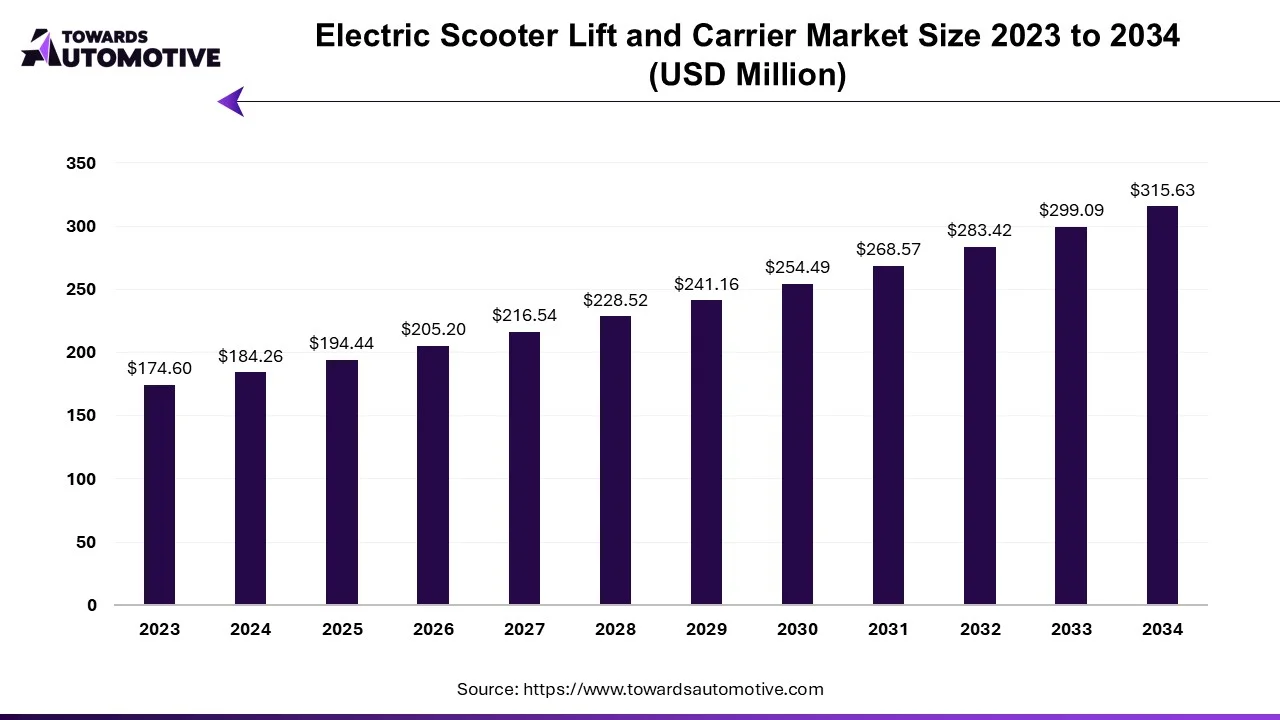
Unlock Infinite Advantages: Subscribe to Annual Membership
The surge in popularity of e-scooters as a convenient mode of transportation has spurred a corresponding demand for auxiliary vehicles such as lift and carry devices. These vehicles serve as indispensable solutions for efficiently transporting e-scooters, catering to the increasing number of individuals who rely on e-scooters for both practical commuting and recreational purposes.
Electric scooters typically range from 8 to 16 miles, contingent upon factors like vehicle size, equipment, user weight, and terrain. Analogous to the miles per gallon metric for cars, heavier loads and faster speeds can diminish total range. Despite the advantage of accessing nearby community services, users often need help to venture beyond their immediate vicinity, necessitating access to public or private transport services. Alongside door-to-door options within urban areas, convenient transportation alternatives like minibuses or shuttles augment mobility options.
The imperative for alternative transportation solutions has arisen from urbanization and associated challenges. By 2022, it's estimated that 57% of the global population will reside in cities, with substantial urban growth observed, particularly in developing regions like Asia and Oceania. This urbanization trend and the rise in city economies underscores the importance of compact and agile transportation solutions like electric scooters. Accessories such as brackets and carriers facilitate easy transport of e-scooters, rendering them ideal for urban residents.
Private transportation often offers greater convenience than public transit, yet accommodating mobility aids like wheelchairs or scooters pose challenges. Veterans and individuals with disabilities must navigate options for transporting their mobility devices, factoring in medical needs and logistical considerations. Safety concerns, compliance with traffic regulations, and compatibility with various scooter models are pivotal considerations influencing the widespread adoption of e-scooter transportation solutions.
Electric mobility scooters, integral for physically disabled individuals, necessitate reliable carriers and lift mechanisms for transporting scooters or chairs. Ensuring the safety and integrity of these devices during transportation is paramount, mitigating risks associated with mechanical failures. Furthermore, government and non-governmental initiatives promoting e-scooter usage are poised to bolster growth within the transportation sector, fostering a conducive environment for e-scooter adoption and innovation.
The COVID-19 pandemic has wrought significant disruptions across various industries, including manufacturing and marine sectors, profoundly impacting the e-scooter and marine industry. As individuals strive to economize and curtail unnecessary expenditures, the repercussions have reverberated throughout the global electric scooter lift and cargo market, precipitating declines in revenue.
The pandemic-induced restrictions on travel and tourism, coupled with constraints on general mobility, have deleteriously affected sales of e-scooter lifts and cargo. The downturn in demand stems from heightened frugality among consumers amidst economic uncertainties and lifestyle adjustments prompted by the pandemic.
Moreover, the manufacturing landscape has been severely disrupted, with widespread closures of production facilities and installations in affected countries. Businesses across the spectrum have grappled with operational challenges, exacerbated by workforce absences due to illness or mandated shutdowns. E-scooter transport and transportation manufacturers have borne the brunt of these disruptions, contending with factory closures and labour shortages, leading to bottlenecks in production and supply chains.
The protracted nature of the pandemic and its far-reaching ramifications underscore the formidable challenges confronting the e-scooter and marine industry. Navigating through these turbulent waters necessitates adaptive strategies, resilience, and a concerted effort to mitigate operational disruptions while fostering innovation and exploring new avenues for growth. As the global community endeavours to emerge from the shadow of the pandemic, the e-scooter and marine industry must remain agile, responsive, and forward-thinking to weather the storm and chart a course towards recovery and revitalization.
The electric scooter lifting and transportation industry is experiencing a paradigm shift towards smart technology integration. This evolution encompasses a range of innovative features including remote control capabilities, tracking systems, and seamless compatibility with mobile applications. These smart features are revolutionizing the user experience by enhancing convenience and accessibility while propelling the overall technological advancement of scooter accessory solutions.
Remote control functionality allows users to effortlessly operate and maneuver their scooter lifting and transportation devices, adding a layer of convenience and ease-of-use to the transportation process. Moreover, tracking systems provide enhanced security and peace of mind by enabling users to monitor the whereabouts of their scooters in real-time, thereby minimizing the risk of theft or loss.
The trend towards lightweight and portable e-scooter lifting solutions is gaining traction within the industry. Urban transportation demands flexibility, prompting companies to innovate and develop compact, easy-to-transport equipment. The emphasis on lightweight design not only enhances user comfort but also aligns seamlessly with the agile mobility of electric scooters, rendering them well-suited for daily commuting and urban mobility needs.
By prioritizing portability and user-friendly design, manufacturers are catering to the evolving needs of urban commuters, who seek convenient and efficient solutions for transporting their electric scooters. This focus on innovation and adaptability underscores the industry's commitment to enhancing the overall user experience while addressing the inherent challenges associated with urban transportation. As the electric scooter lifting and transportation market continues to evolve, smart technology integration and lightweight design principles are poised to drive further advancements and shape the future of urban mobility solutions.
Electric power has gained traction in the market, fueled by the emergence of new options that make electric scooters viable for long-distance travel. Performance enhancements and innovations in electronic control systems, power equipment, and crane technology are pivotal in driving product demand. Initially, electric scooter lifts and cargo solutions required manual operation. However, vendors have leveraged technology to integrate various functions, enhancing efficiency and convenience. Advancements in hydraulic technology, in particular, have contributed to making the lifting process more portable and efficient.
Numerous companies are developing new products to support the burgeoning electric scooter lifting and transportation industry. For instance, Harmar introduced the LiftSquad installation technology support network in October 2018, augmenting its service portfolio with enhanced installation capabilities. With the ability to support approximately 1000 customer installs per month, this initiative reflects the industry's commitment to meeting growing demand and providing comprehensive solutions to customers.
The electric scooter lift and transportation industry is experiencing robust growth driven by advancements in energy production, the expansion of power plants, increasing tourism and travel activities, and ongoing innovations in product development and service offerings. As the market continues to evolve, companies prioritizing technological innovation, product quality, and customer service are poised to thrive in this burgeoning sector.
The electric scooter lifts and carriers market is poised for substantial growth, driven by several key factors that are shaping the landscape of urban transportation and personal mobility. By analyzing market trends and dynamics, it becomes evident that the market is experiencing significant shifts, particularly in terms of segment growth, regional dominance, and driving factors.
Outdoor segment dominance: the outdoor segment is projected to capture a substantial portion, approximately 64%, of the market share by 2023. This surge is primarily attributed to the burgeoning popularity of e-scooters for leisure and travel purposes. As urban development accelerates and the need for efficient long-distance transportation solutions rises, e-scooters emerge as the preferred mode of travel. External carriers play a pivotal role in meeting this demand by facilitating easy transportation of scooters over extended distances or across different modes of transportation. Their versatility, user-friendliness, and compatibility with various scooter models further fuel the growing demand for external lifting solutions.
Personal travel preference: personal travel applications are expected to account for approximately 55% of the market share by 2023. The increasing adoption of e-scooters for personal transportation stems from the safety, convenience, and efficiency they offer. As urban areas expand, individuals seek solutions to alleviate congestion and navigate densely populated areas. Electric scooter lifts address this need by simplifying the process of transporting scooters over long distances or integrating them with other modes of transportation. The demand for adaptable, seamless, and individualized mobility solutions, coupled with the compact and portable nature of e-scooters, is driving the uptake of efficient and user-friendly transport and handling solutions.
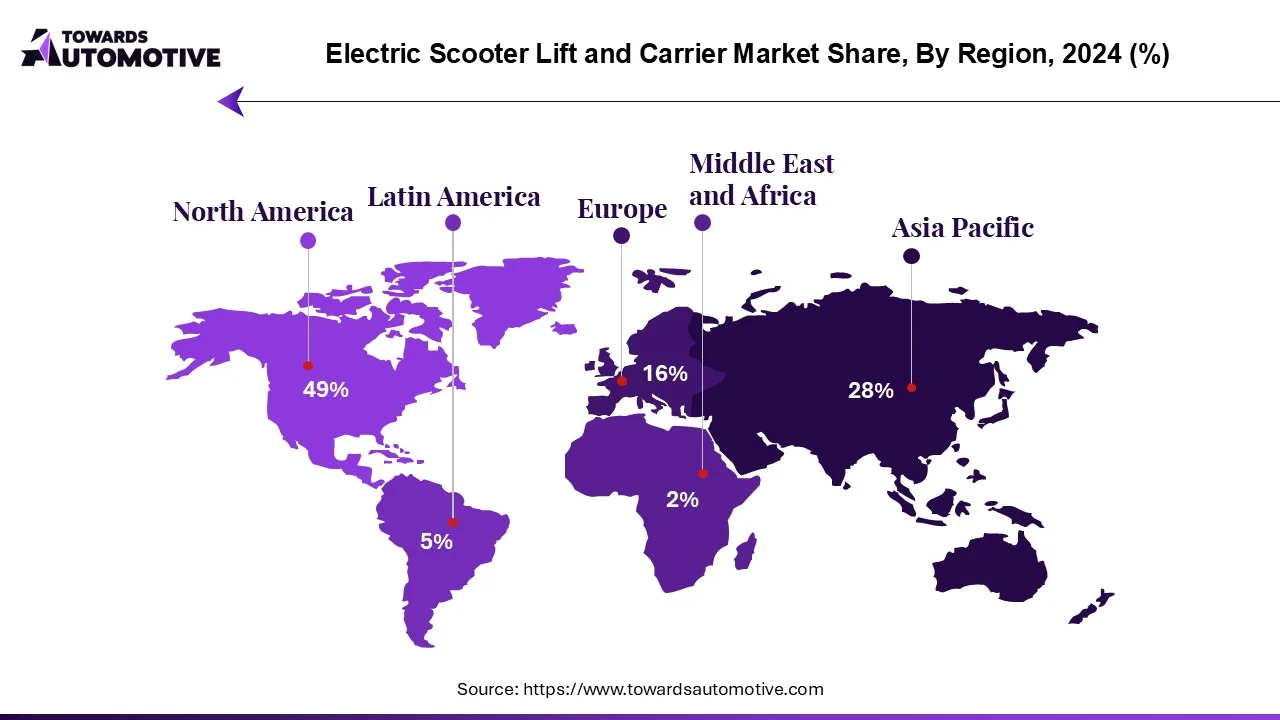
North America is poised to dominate the market, with a projected market share of approximately 42% by 2023. Several factors contribute to the robust growth of the electric scooter lift and carrier market in the region. Increasing environmental consciousness has spurred the adoption of e-scooters as eco-friendly alternatives to conventional personal transportation modes. Additionally, the region boasts robust infrastructure and a growing awareness of electric vehicle options, further bolstering market growth in North America.
The electric scooter lifts and carriers market is witnessing rapid expansion driven by the convergence of various factors such as changing consumer preferences, urbanization trends, and technological advancements. As the market continues to evolve, stakeholders must stay attuned to emerging opportunities and adapt their strategies to capitalize on the burgeoning demand for efficient and sustainable mobility solutions.
Allied Motion Technologies Inc. is a frontrunner in the electric lifting and hoisting business, demonstrating a steadfast commitment to innovation and technological advancement within the realm of electric scooter lifting and transportation. The company's strategic initiatives underscore its dedication to staying ahead of the competition and catering to evolving customer demands.
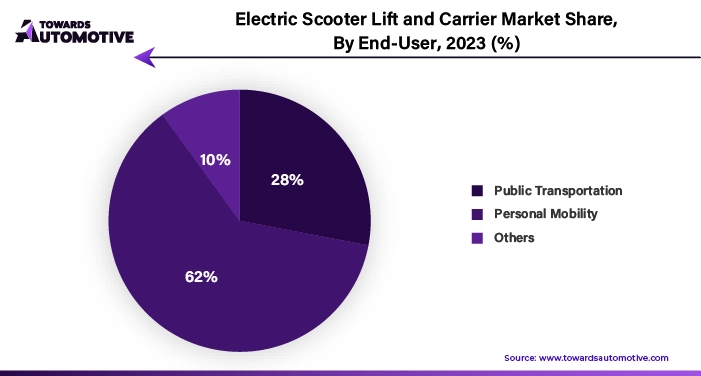
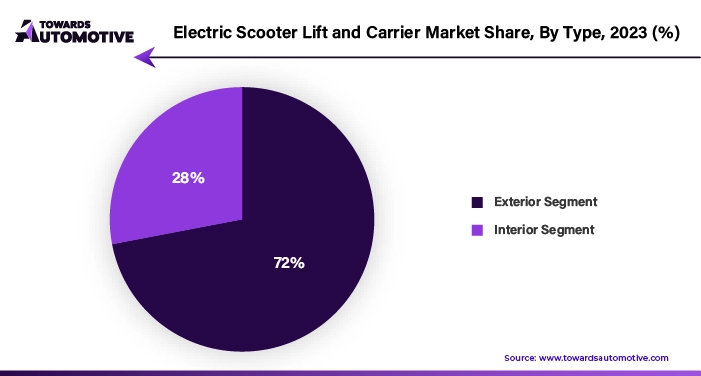
Overall, Allied Motion Technologies Inc. stands out as a leader in the electric lifting and hoisting business, driven by its unwavering commitment to innovation, customer-centricity, and technological excellence. Through its strategic initiatives and focus on meeting customer needs, the company continues to set industry benchmarks and pave the way for future advancements in electric scooter lifting and transportation solutions.
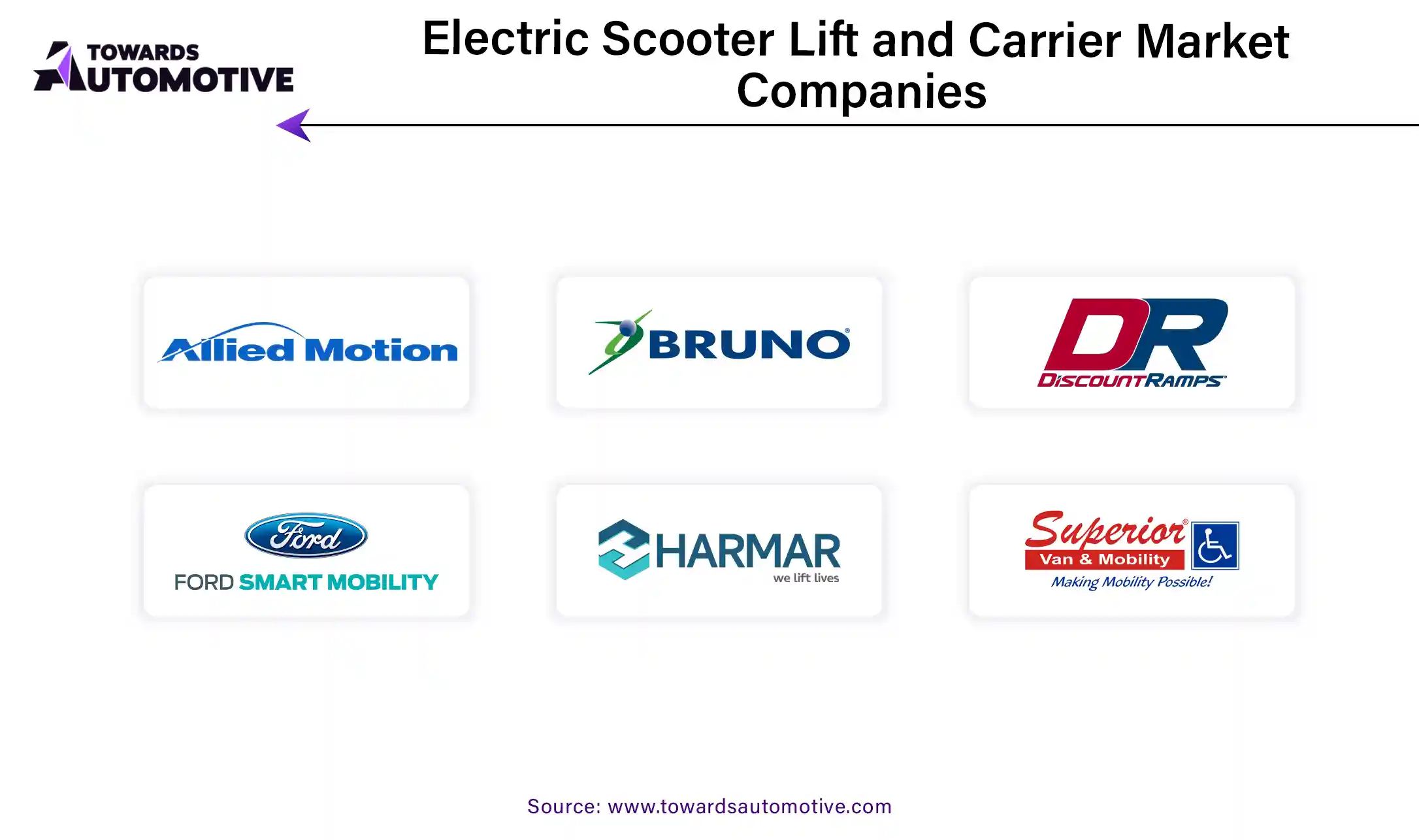
Major players operating in the electric scooter lift and carrier industry are
By Type
By Sales Channel
By Geography
September 2025
September 2025
September 2025
September 2025
We offer automotive expertise for market projections and customizable research, adaptable to diverse strategic approaches.
Contact Us